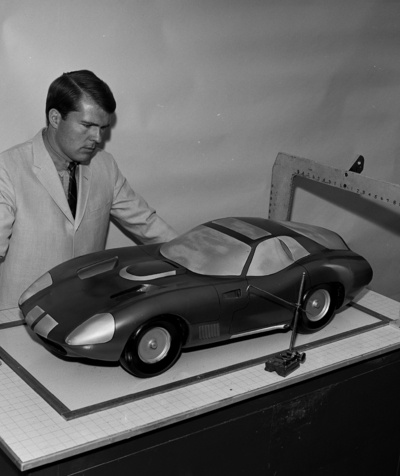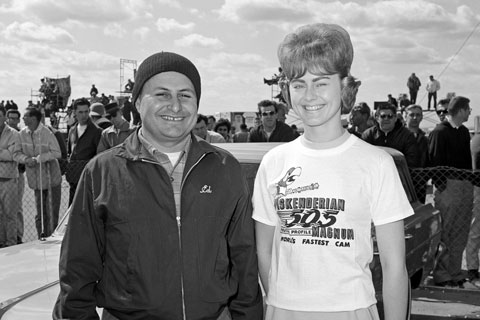SEMA News—September 2020
HERITAGE
Stillborn Shelby
By Drew Hardin
Photography Courtesy Darrel Norenberg, Petersen Publishing Company Archive
 |
The film Ford v Ferrari gave us a taste of the turbulent relationship Carroll Shelby had with the Ford Motor Company. Despite nearly constant friction between the maverick in Los Angeles and management in Dearborn, there were great successes, to be sure. But there were also some missed opportunities. Such was the case with the Type 65, also known as the Daytona Super Coupe.
The Type 65, like the championship-winning Shelby Daytona Coupes that came before it, was designed by Peter Brock, who was photographed for Sports Car Graphic magazine in February 1965 with a scale clay model of the car. Brock called the Type 65 Shelby’s “back-up plan in case he didn’t get the hoped-for GT40 program.”
Even with the Daytona Coupe’s racing success, Shelby’s role in the GT40 program was not secure in 1965. Middle managers at Ford “were long-time backers of Holman Moody and felt any race program should be awarded there,” Brock said. As a result, Shelby received just a partial contract to work on the GT40. The Type 65, then, was a contingency, “to be ready for the last part of 1965 and 1966 and be competitive with whatever Ford had.”
Mechanically, the Type 65 would be like the Mk II Cobras in development at the time. It would be built on the Mk II’s 92-in.-wheelbase chassis and be powered by a big-block engine.
“It was a bigger car all around,” Brock said. “It was a clean-sheet design, but everything was taken from the Daytona. Everything I learned on the Daytona that was wrong—I made a lot of mistakes—was refined on this car.”
Two interesting details are visible on the model. The low power bulge on the hood made room for a single four-barrel carburetor on top of an all-aluminum 390ci V8.
“We learned from the 427 engines, after Ford tried all kinds of carburetors, that they ran best with a four-barrel carburetor,” Brock said.
Also note the window in the roof.
“One thing I learned from the original Daytona Coupe was that the banking at Daytona was so steep, when the driver looked out the windshield, he could only see about 100 yards ahead,” Brock recalled. “With the brakes we had in those days, there was no way to stop in that distance going almost 200 mph. But if the driver could look out of the roof, he could see all the way down the track where he was going and plan what he wanted to do.”
The aluminum bridge behind the model was a tool Brock used with rods placed in its holes “so I could measure the model and draw up the car’s plans,” he explained. Brock and Shelby intended to have the Type 65’s aluminum body made by Carrozzeria Grand Sport in Modena, Italy, which had built five of the six Daytona Coupe bodies. Ford had other plans.
“Unknown to Carroll at the time, Ford had decided that Shelby was going to be ‘the team’ to represent Ford in 1966, so obviously they weren’t too happy to learn Carroll had his own car planned,” Brock said. The Type 65’s plans “were given to Ford guy Peyton Cramer, who, without telling Shelby—and probably under secret Ford orders—gave them to a company called Harold Radford in the UK.”
Radford was under contract to make interiors for the GT40s, but its work was so expensive—“seven thousand bucks apiece for them,” Brock said—that Cramer was tasked with cancelling the contract. Desperate to keep the job, Radford offered to throw in work on the Type 65.
“They had zero experience in building race cars and proved totally incompetent,” Brock said. He went to England to try to put things right, “but it was hopeless. They couldn’t get the right materials and didn’t have the right people with the right skills to build it.”
The Type 65 got to about 80% complete, but it was “so badly built—so heavy and badly proportioned—that it wasn’t close to what I intended,” Brock said.
In the end, it didn’t matter. Ford gave Shelby the full GT40 program, at which point “Shelby didn’t care anymore about the Type 65,” Brock said. The project was cancelled, and the in-progress car was shipped back to Los Angeles and “lost” in a warehouse. It was later sold at Shelby’s liquidation auction, was ultimately finished, participated in several vintage races, and sold at a collector-car auction in 2007 for more than $1.3 million.
“Had the car been built in Italy as planned, it would have been a handsome car and competitive with the GT40s,” Brock believes to this day. “But, of course, Ford didn’t want any more competition than they were already facing with Enzo!”






